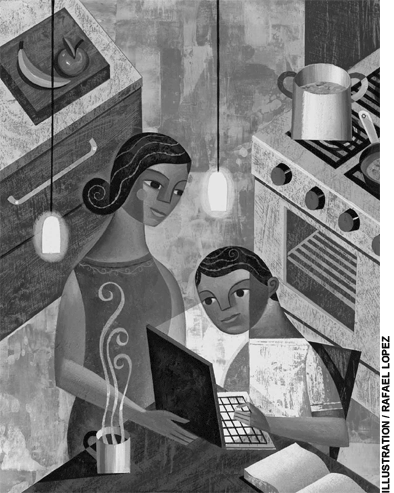 “I never really told anybody about my music at school, only my really close friends,” Cheyenne Kimball told People Magazine in 2006. “Then [school officials] actually aired the show around the whole entire school, and that caused a lot of problems. I was a straight-A student and all of a sudden I didn’t want to go to school anymore because of the things people were saying. That’s why I’m home schooled now.” Cheyenne, winner of NBC’s America’s Most Talented Kid at age 12, recording artist, and star of her own MTV show, is just one of many high-profile Americans whose educational choice is home schooling. Movie stars Will Smith and Jada Pinkett Smith, married in 1997, home school their two children alongwith Will’s nephew. Why? “For flexibility,” Pinkett Smith told an Essence reporter, “so they can stay with us when we travel, and also because the school system in this country—public and private—is designed for the industrial age. We’re in a technological age. We don’t want our kids to memorize. We want them to learn.” While home schooling may have particular appeal to celebrities, over the last decade families of all kinds have embraced the practice for widely varying reasons: no longer is home schooling exclusive to Christian fundamentalism and the countercultural Left. Along with growing acceptance of home schooling nationally has come increasing diversification of who home schools and of what home schooling actually means.
“I never really told anybody about my music at school, only my really close friends,” Cheyenne Kimball told People Magazine in 2006. “Then [school officials] actually aired the show around the whole entire school, and that caused a lot of problems. I was a straight-A student and all of a sudden I didn’t want to go to school anymore because of the things people were saying. That’s why I’m home schooled now.” Cheyenne, winner of NBC’s America’s Most Talented Kid at age 12, recording artist, and star of her own MTV show, is just one of many high-profile Americans whose educational choice is home schooling. Movie stars Will Smith and Jada Pinkett Smith, married in 1997, home school their two children alongwith Will’s nephew. Why? “For flexibility,” Pinkett Smith told an Essence reporter, “so they can stay with us when we travel, and also because the school system in this country—public and private—is designed for the industrial age. We’re in a technological age. We don’t want our kids to memorize. We want them to learn.” While home schooling may have particular appeal to celebrities, over the last decade families of all kinds have embraced the practice for widely varying reasons: no longer is home schooling exclusive to Christian fundamentalism and the countercultural Left. Along with growing acceptance of home schooling nationally has come increasing diversification of who home schools and of what home schooling actually means.
Though parents and tutors have been teaching children in the home for centuries, in the late 1960s and 1970s there emerged for the first time in the United States a political movement that adopted this practice as a radical, countercultural critique of the public education system. Conservatives who felt the public schools had sold out to secularism and progressivism joined with progressives who felt the public schools were bastions of conservative conformity to challenge the notion that all children should attend them. By the early 1990s they had won the right to home school in every state. Some home-school advocacy groups have attempted to secure a federal law or Supreme Court ruling that would establish uniform national guidelines grounded in First or Fourteenth Amendment rights, but to date such efforts have failed (to the great relief of home-school advocacy groups that oppose this strategy). Home schooling thus falls under state law, and these laws vary widely. A complex matrix of specific statutory language and judicial interpretations emerged out of the maelstrom of political activism over the issue that started in the late 1970s. In Indiana and Michigan, for example, there are virtually no restrictions on home schoolers and very little accountability to government. Home-schooling parents are not even required to register. In Pennsylvania and New York, state agencies oversee and regulate home schooling in a number of ways, from curricular requirements to parental qualifications to mandatory home visits by certified personnel to obligatory standardized testing.
By the 21st century, state laws were well established and uncontested, though nearly every year state legislators or judges, especially in the most permissive states, seek to increase regulations on home-schooling families in the name of accountability. Such initiatives nearly always fail due to the astonishing grass-roots organization and political mobilization of home schoolers. The most recent challenge to home schooling arose when a California court cited a 1929 state law that ostensibly requires home tutors to be state-certified. After several months of protests and concomitant uncertainty for the 160,000 home-schooled children in the state, the court reversed the ruling to permit home schooling as a “species of private school education” and came surprisingly close to finding in the federal Constitution a right to home school.
Reliable nationwide numbers are difficult to obtain, but the National Center for Education Statistics estimates that from 1999 to 2003 the number of home-schooled children increased from around 850,000 to roughly 1.1 million, a 29 percent jump in four years. Movement leaders suggest even higher estimates of around 2 to 2.5 million children currently being home schooled. Some states keep their own figures. Virginia had 3,816 registered home schoolers in 1990. By 2007 the number had grown to 20,694. Maryland saw similar growth, from 2,296 in 1990 to 24,227 in 2006.
After three decades of explosive growth, the rate of increase in home schooling has begun to slow somewhat, and home-schooling rates are even declining a bit in some states. In Pennsylvania, there were 24,415 reported home schoolers in 2002, the largest figure the state had ever seen. But in 2003 the number of registered home schoolers dropped to 24,076. In 2004 it declined again to 23,287, a decrease of 3.3 percent from the previous year.
Among the possible explanations for declines in home schooling is the increased use of home-based public charter schools, often called “cybercharters” because of their extensive use of online curricula, by families that had previously been home schooling independently. Home schooling is blending with other education movements to lead the way toward a 21st-century education matrix that is far more dynamic and adaptive than the schooling patterns of the past.
The New Home Schoolers
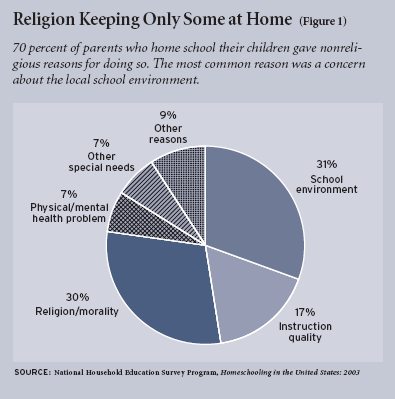
Survey research has revealed a heterogeneous population of home schoolers and higher rates of minority home schooling than expected. Economist Guillermo Montes’s analysis of data from the massive 2001 National Household Education Survey found that 70 percent of respondents cited a nonreligious reason as the top motivator in their decision to home school. Home schoolers whose motivations are primarily religious have certainly not gone away, but they are now joined by those whose reasons range from concerns about special education to bad experiences with teachers or school bullies to time-consuming outside activities to worries over peanut allergies (see Figure 1).
Increasing participation in home schooling among African Americans has drawn media attention in recent years. The U.S. Department of Education estimated that by 2003 there were 103,000 black home schoolers (see Figure 2). Nonprofits, including the Children’s Scholarship Fund, founded in 1998, have provided vouchers to help low-income families afford private schools, and some are using the money to home school. Several nationwide support groups have been formed by African Americans to build momentum; the newest and largest is the National African-American Homeschoolers Alliance, cofounded in 2003 by Jennifer James. By 2006 the organization had 3,000 members. James learned of home schooling by watching the success of home schoolers at the Scripps National Spelling Bee and embraced it for her family. “Families are running out of options,” James told the St. Petersburg Times in 2005. “There’s this persistent achievement gap, and a lot of black children are doing so poorly in traditional schools that parents are looking for alternatives.” Home schooling is becoming the method of choice for many, and as such “the Black homeschool movement is growing at a faster rate than the general homeschool population,” according to J. Michael Smith, president and cofounder of the Home School Legal Defense Association (HSLDA), the nation’s most powerful home-school advocacy organization.
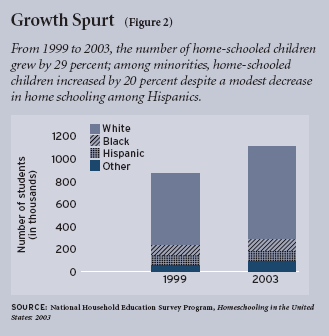 Growth in home schooling can be spotted among other ethnic and religious groups as well. Native Americans in Virginia and North Carolina have founded home-school organizations in an effort to escape assimilationist public schools and preserve their traditional values. Hawaiian natives have found home schooling to be the solution to the gulf between tribal ways and public education. Jews, especially those who follow the Orthodox tradition, have been home schooling in much greater numbers in recent years. While Roman Catholic families have long had a presence in the home-schooling world with such institutions as the Virginia-based Seton Home Study School (founded in 1980), recent years have seen an explosion in Catholic home schooling and resources. Islamic home schooling has also grown rapidly, especially since 9/11, largely because “the public school system is not accommodating to Muslims,” in the words of Fatima Saleem, founder of the Palmetto Muslim Homeschool Resource Network.
Growth in home schooling can be spotted among other ethnic and religious groups as well. Native Americans in Virginia and North Carolina have founded home-school organizations in an effort to escape assimilationist public schools and preserve their traditional values. Hawaiian natives have found home schooling to be the solution to the gulf between tribal ways and public education. Jews, especially those who follow the Orthodox tradition, have been home schooling in much greater numbers in recent years. While Roman Catholic families have long had a presence in the home-schooling world with such institutions as the Virginia-based Seton Home Study School (founded in 1980), recent years have seen an explosion in Catholic home schooling and resources. Islamic home schooling has also grown rapidly, especially since 9/11, largely because “the public school system is not accommodating to Muslims,” in the words of Fatima Saleem, founder of the Palmetto Muslim Homeschool Resource Network.
Large numbers of parents whose children have diagnosed learning disabilities have pulled them from local schools, believing they can do a better job teaching them at home. Increasing numbers of wealthy Americans are hiring private tutors for their children. The U.S. Department of Education estimated that in 2003, 21 percent of home schoolers were being taught this way. Business Week editor Michelle Conlin explained the appeal of home education to “creative-class parents” as an outgrowth of the “spread of the post-geographic workstyle” and “flex-time economy.”
A final group of home schoolers that should be mentioned is children involved in sports requiring rigorous training, acting and modeling, demanding arts or music programs, and other time-intensive activities. In motocross, where an elite-level 13-year-old can earn over $100,000 a year, 90 percent of minors are either home schooled or dropouts. Circe Wallace, a retired snowboarder turned action-sport agent, remarked in 2006, “I’ve been in this business 15 years, and it’s always been those with parents that understand the freedom and flexibility of home schooling that go the furthest.” Orange County gymnast Katy Nogaki was 11 years old when she told a reporter, “my coaches…said if I home schooled, I could come to the gym early and I could get really far in gymnastics …. When I was in regular school, I wasn’t as good, but when I was home schooled, I got state champion.”
Many of the new breed of home-schooling parents, even if they do not become dues-paying members of home-schooling political organizations, still need help with pedagogical or curricular decisions, playmates for their children and companionship for themselves, and opportunities to get out of the house for a while. Home-school support groups can serve as remarkably diverse social networks. In a National Home Education Network online forum, Pam Sorooshian described her Southern California group:
My homeschooling group includes Moslem, Jewish, Quaker, Baptist, Messianic Jews, Pagan, Baha’i, atheist, agnostic, Catholic, unity, evangelicals, other Protestant denominations, and probably more. We have African Americans, Latinos, Asians, Middle Easterners, and other minorities. We have stay-at-home dads and single mothers. We are FAR more diverse than the neighborhood school I pulled my oldest child out of 10 years ago.
In short, home education is now being done by so many different kinds of people for so many different reasons that it no longer makes much sense to speak of it as a political movement or even a set of movements. Make no mistake: the veteran political movement is still going strong, as legislatures that attempt to increase regulations quickly discover. For a growing number of Americans, however, home schooling is just one option among many to consider, for a few months or for the entirety of a child’s schooling.
New Home Schooling in Practice
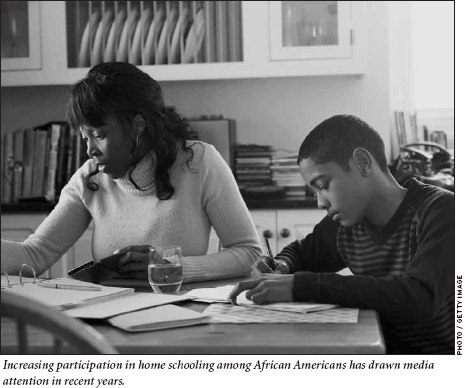
Home-schooling families of the 1980s and 1990s fell somewhere along a continuum of pedagogical practice bounded on the left with “unschooling,” a word coined by educator John Holt to describe the liberation of children from adult-imposed constraints on their learning. Unschoolers had no formal curriculum, no tests, grades, schedules, or benchmarks. Instead, children were free to do as they please with the parent serving largely as a facilitator of the child’s individual growth and development. On the righthand side of the continuum was the formal “school in a box” approach whereby a parent purchased a full year’s worth of textbooks, worksheets, tests, and assignments and attempted to reproduce in the home the same basic pedagogical strategies practiced in most schools. Not surprisingly, progressive types leaned toward unschooling and conservative Protestants trended toward formal curricula, usually provided by fundamentalist private schools, the most popular being A Beka Book, Bob Jones Complete, and Christian Liberty Academy Satellite Schools.
While some families began on one side of the continuum and stayed there, most gradually incorporated something from both approaches. The most typical progression according to a 1999 study by Karen Rogers Holinga was from complete dependence on a prefabricated curriculum in the first year of home schooling to a more flexible, eclectic orientation by the third. Nevertheless, since the great majority of home schoolers in the 1980s and 1990s were conservative Protestants, Christian presses did a brisk business selling textbooks and other material to them, at huge annual conventions attended by thousands, at local Christian bookstores, and, increasingly, over the Internet.
Home schoolers have for some time been creating hybrids that blend elements of formal schooling into the usual pattern of a mother teaching her own children at home (see Figure 3). One of the simplest hybrids is the “Mom School.” Pioneer Utah home schooler Joyce Kinmont explains, “a Mom School happens when a mother is home schooling a child who wants to do something that can be done best in a group, so she invites other home-schooling families to join her. The mom is the teacher.” Related but slightly different is the home-school cooperative, wherein a group of mothers (and sometimes fathers) pool their expertise, each teaching a subject she knows well to all the children in the group. Sometimes such co-ops are held in the homes of respective group members, but often they meet in area churches or other buildings.
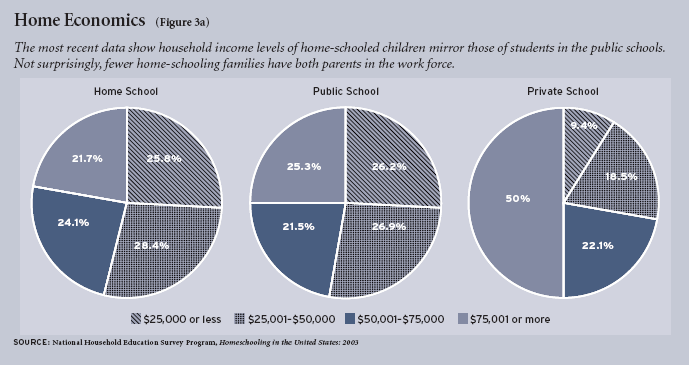
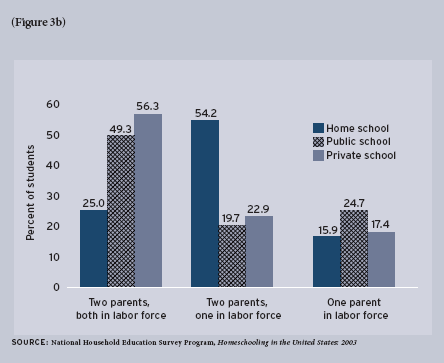
The most successful and developed cooperatives begin to look quite a bit like schools, with an adult teacher in the front lecturing to rows of students sitting quietly at desks, sometimes hiring experts to teach advanced subjects like calculus, foreign languages, or physics. Others carry a more free-flowing pedagogy into the new setting. North Star, a Massachusetts cooperative billing itself as “self directed learning for teens,” was formed in 1996 by two disgruntled public school teachers. At North Star, no attendance is taken, no grades or evaluations offered. Students learn about whatever they want. In 2006, students asked for and got tutoring in Greek mythology, historical interpretation, Shakespeare, prime numbers, martial arts, culture and belief, electronic music, dance, historical fiction, and much more. Most students engage in apprenticeships and internships in the local community. Though the graduates receive no transcript or degree, a 2006 Teacher Magazine article reported that 49 percent of alumni had been accepted to college and 49 percent had secured full- or part-time jobs.
While large numbers of home-schooled kids transition to traditional schools in their teen years, home schooling for older children is a high-growth market, and there has been an explosion in innovative programs for them. Home schoolers have challenged and are increasingly overturning laws barring them from participation in high school sports and other extracurricular activities offered by public schools. Journalist Peter Beinart found that Wichita’s 1,500 home-schooling families had created “three bands, a choir, a bowling group, a math club, a 4-H Club, boy- and girl-scout troops, a debate team, a yearly musical, two libraries and a cap-and-gown graduation.” “Home-schooled” children were meeting in warehouses or business centers for classes “in algebra, English, science, swimming, accounting, sewing, public speaking, and Tae Kwan Do.”
Many with roots in conservative Protestantism have had trouble adjusting to the more worldly culture that often accompanies cooperatives, especially ambitious endeavors like sports leagues and orchestras. Disagreements over “what kinds of uniforms are appropriate for home-school cheerleaders and whether rock music may be played at home-school events” are not uncommon, says Beinart, as lifelong home schoolers rub shoulders with families fresh from the public schools.
Blurred Boundaries
None of the small-scale culture skirmishes begin to match the controversy generated by the growing popularity of government-sponsored initiatives for home schoolers, however. Many public school districts, having lost the fight to criminalize home schooling, now openly court home schoolers. School districts around the country are experimenting with programs that allow students to home school for part of the day but take certain classes at the local public school.
School districts with high rates of home schooling have seen significant drops in funding, tied as it is to per-pupil enrollment. The Maricopa County school district in Arizona, for example, had by the year 2000 lost $34 million due to the exodus of 7,526 home schoolers. In an effort to win some of them back, the district began offering à la carte services through satellite campuses at strip malls and other locations. Home schoolers there have attended weekly enrichment classes in such subjects as sign language, art, karate, and modern dance. The district receives one-quarter of each pupil’s government allocation for every student it enrolls in one of the classes. The state of Washington has been a national leader in establishing such partnerships. At the Homeschool Resource Center operated by the Seattle Public School District, home-schooled children can choose from a rotating menu of classes or just stop by to use the computer center or library.
The College Board has seen a dramatic rise in home schoolers who take Advanced Placement tests. Some 410 home-schooled students took them in 2000, while 1,282 did so in 2005. Home-schooling diploma services have multiplied across the country, as have honor societies like the Houston-based Eta Sigma Alpha. Many states have begun to extend to home schoolers the popular dual-enrollment programs (sometimes called “Running Start”) that allow high-school students to enroll for free in classes at local colleges. Florida and Washington are perhaps the national leaders in establishing such programs, but other states are warming to the possibility.
Not surprisingly, all of this innovation and experimentation at the secondary level has led to a dramatic rise in applications to institutions of higher education by students without a traditional high-school background. In 1986, 90 percent of the nation’s colleges and universities had no explicit home-schooling admissions policy. A 2004 study by Paul Jones and Gene Gloeckner found that by that year, over 75 percent of the institutions did, and that the majority of admissions officers surveyed had very positive feelings about home-schooled applicants. Another 2004 study by Sean Callaway of Pace University, of the home-school admissions policies of 72 colleges and universities and the performance of home-schooled students who were enrolled, found that home schoolers were generally happy with the way they were evaluated and universities were happy with the performance and graduation rates of the home schoolers they admitted.
Virtual Schools
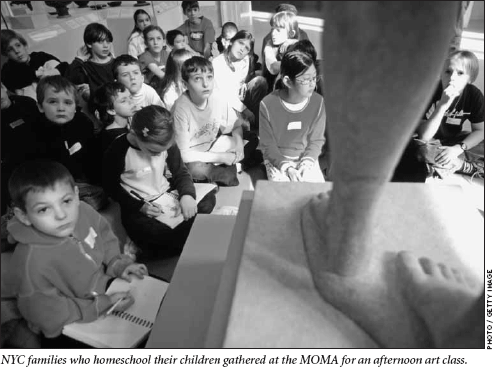
Among the most innovative and successful of the public-private hybrids is the Florida Virtual School (FLVS), founded in 1997 and operated by the Florida Department of Education. It partners with all 67 Florida school districts to bring a complete high-school curriculum moderated by certified teachers to the homes of residents across the state, many of whom live on isolated produce farms or ranches. In the 2006–07 school year, more than 52,000 students were enrolled in FLVS. By 2006, 21 other states and several local districts had begun similar programs, both to service homebound or other special-needs students and as an effort to lure home schoolers (and the tax dollars they represent) back into the public education system.
More provocative have been online schools founded by private companies that have taken advantage of charter school laws in various states to make their services available for free to home schoolers. California was an early innovator, with virtual charter schools opening shortly after the Charter Schools Act was passed in 1992. By 2001 the state had 93 cybercharters serving more than 30,000 students, which meant that over $200 million of California’s public school budget was being paid to private firms offering home-school curricula and technology. After it became clear that some of these outfits were making scandalous profits by offering minimal services, California legislators passed SB 740, which imposed strict financial guidelines on cybercharters, including a requirement that they spend at least 50 percent of public revenues on salaries and benefits to state-certified teachers. The law also set limits on pupil-teacher ratios, required more expansive record keeping, and imposed strict penalties for failing to meet these and other standards.
By 2006, 18 states had a combined total of 147 virtual charter schools educating over 65,000 students. Many cybercharters have faced growing pains similar to those seen in California. The Western Pennsylvania Cyber Charter School (WPCCS) opened its virtual doors in the fall of 2000 as Pennsylvania’s second cybercharter and the first to offer its services across district lines. After nine months enrollment topped 1,100. Many school districts, frustrated that they now had to pay an outside organization to educate students in their own districts, many of whom had not even attended public schools before, simply stopped making payments, causing WPCCS to lose nearly $1 million in 2001. The Pennsylvania Department of Education responded by withholding $850,000 in state aid from 60 districts, sending the money directly to WPCCS. Lawsuits were filed by 23 districts, and in May of 2001 senior judge Warren Morgan ruled against the school districts. That did not stop complaints about WPCCS and several other cybercharters. In 2002 the state legislature passed Act 88, shifting authorization of cybercharters from local districts to the state department of education and setting more rigorous requirements and accountability measures. Despite increased scrutiny, virtual charters have continued to grow. By 2008 WPCCS, now called PA Cyber, was employing 500 people to educate 8,500 students on a $60 million budget.
For-profit cybercharters have many enemies. Many politicians and public school advocates agree with Democratic Rep. Patrick Rose of the Texas state legislature that “we ought not be in the business of supporting for-profit education. Any program that takes money out of our public schools would be against our better judgment.” Profits have indeed been sweet for many cybercharters, operating as they do without extensive facilities and support staff, though advocates always stress the cost of developing curriculum, advertising, and computer networks, as well as of high turnover rates. Cybercharter advocates and entrepreneurs are not surprised at the criticism (and lawsuits, nearly all of which have been unsuccessful) they have been handed from public school districts, Democratic legislators resistant to educational choice initiatives, and teachers unions. What has taken them off-guard, however, is the vocal and bitter opposition among many leaders in the home-schooling community. Right- and left-wing home-schooling leaders have set aside long-standing grudges to unite in protest of virtual schools. In 2003, dozens of home-school leaders from a wide range of ideological positions signed a resolution condemning virtual charter schools called “We Stand for Homeschooling.” The Home School Legal Defense Association did not sign the statement but has heaped condemnation on cybercharters. Elizabeth Smith, wife of HSLDA’s president, in a 2007 address urged her audience of Protestant home-school leaders to pray against the “assault of the Enemy” that cybercharters represented: “if we will band together…through prayer…our groups will win.”
Cybercharter backers have had difficulty understanding and responding to such criticism. Ron Packard, founder and CEO of K12, a curriculum provider whose services in 2007 reached over 25,000 students through virtual schools in 16 states and the District of Columbia, has been “shocked” by opposition coming from HSLDA. He told CNSNews.com, “It’s really amazing to me that a group that has fought so hard for its right to home school would oppose someone else’s parents who are fighting for their right to be doing at home a great public school education.” Home-school movement leaders’ reactions do make sense, however. Animus toward government was what bound leftist and conservative Christian home schoolers together in the 1970s and 1980s, and it is what has brought them back together to oppose virtual charters.
For veteran Christian leaders especially, the cybercharter movement has cut in on their business. HSLDA senior counsel Chris Klicka explains how “even in independent-minded states like Idaho and Alaska” Christian home schoolers are enrolling in cybercharters “by the thousands. They are attending government home-school conferences (where Christ or God cannot be mentioned) and receiving the secular, government home-school newsletters. They no longer go to the Christian home-school conventions.” Christian curriculum providers have lost market share as well. Christian home schoolers who would otherwise be purchasing Christian curricula as independent home schoolers now receive nonreligious, government-sanctioned curriculua for free through cybercharters. It is only natural that Christian companies would resent such a move and interpret it as a clandestine effort by the secularist state to destroy them. Despite the united front of opposition, with studies like Carol Klein’s 2006 Virtual Charter Schools and Home Schooling finding high levels of parent satisfaction and student achievement at virtual schools, it is highly unlikely that independent home schoolers and advocates for traditional public schools will be able to stop them.
The increasing diversity of home schoolers and institutional configurations should not obscure the fact that many who home school still choose this option out of frustration with or protest against formal, institution-based schooling and seek to impart an alternative, usually conservative Christian, worldview to their children by teaching them at home. Yet it is also the case that increasing numbers who opt to home school do so as an accessory, hybrid, or temporary stopgap, or out of necessity given their circumstances. It is this newer group of home schoolers who are challenging the historical dichotomies between public and private, school and home, formal and informal that have played such an important role in the movement’s self-definition and in American education policy. Trends toward accommodation, adaptation, and hybridization will likely increase as U.S. education policy seeks to catch up to the sweeping demographic, technological, and economic changes taking place. A movement born in opposition to public schools ironically might offer public education its most promising reform paradigm for the 21st century.
Milton Gaither is associate professor of education at Messiah College and author of Homeschool: An American History, from which this article was adapted. His blog reviewing recent research on home schooling can be found at gaither.wordpress.com.


